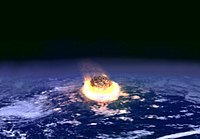
Photo from wikipedia
Abstract Although a large number of astronomical craters are actually produced by the oblique impacts onto inclined surfaces, most of the laboratory experiments mimicking the impact cratering have been performed… Click to show full abstract
Abstract Although a large number of astronomical craters are actually produced by the oblique impacts onto inclined surfaces, most of the laboratory experiments mimicking the impact cratering have been performed by the vertical impact onto a horizontal target surface. In previous studies on the effects of oblique impact and inclined terrain, only one of the impact angle φ or target inclination angle θ has been varied in the experiments. Therefore, we perform impact-cratering experiments by systematically varying both φ and θ. A solid projectile of diameter Di = 6 mm is impacted onto a sand surface with the range of impact velocity vi = 7–97 m s−1. From the experimental result, we develop scaling laws for the crater dimensions on the basis of Π-group scaling. As a result, the crater dimensions such as cavity volume, diameter, aspect ratio, and depth-diameter ratio can be scaled by the factors sin φ and cos θ as well as the usual impact parameters (vi, Di, density of projectile, and surface gravity). Finally, we consider the possible application of the obtained scaling laws to estimate impact conditions (e.g., impact speed and impact angle) in natural crater records.
Journal Title: Icarus
Year Published: 2020
Link to full text (if available)
Share on Social Media: Sign Up to like & get
recommendations!